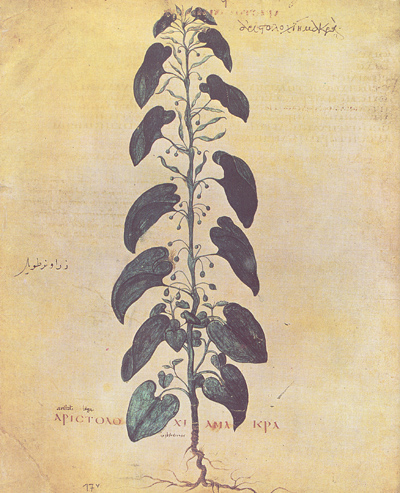"Krateuas, Dionysios and Metrodoros adapted a most attractive method, though one which makes clear little else except the difficulty of employing it. For they painted likenesses of the plants and then wrote under them their properties. But not only is a picture misleading when the colors are so many, particularly as the aim is to copy nature, but besides this, much imperfection arises from the manifold hazards in the accuracy of copyists. In addition, it is not enough for each plant to be painted at one period only of its life, since it alters its appearance with the fourfold changes of the year."
Pliny, Natural History (XXV.4)
Court physician to Mithridates VI, king of Pontus (120-63 BC), Crateuas was a rhizotomist (root cutter or herb gatherer), whose own illustrated herbal, the oldest treatise on pharmacology and the first to be illustrated, has been lost. Dioscorides speaks respectfully of him in his preface, although commenting that he did omit "many exceptionally useful roots and a few herbs." Singer contends that eleven illustrations in the Codex Vindobonensis, beginning with the one above, which are especially well drawn and include quotations from Crateuas, may have been copied from the earlier work.
Riddle argues, however, that both Crateuas and Dioscorides originally were written on papyrus scrolls. Their drawings would have been in ink wash; otherwise, the paint would have cracked and flaked off as the scroll was rolled and unrolled. The paintings on parchment in the Vienna Discorides seem to him to be too finely detailed to have been copied from such crude originals (indeed, Pliny is dismissive of their accuracy). That De Materia Medica, itself, originally was illustrated can be assumed from the text, which very often does not describe the plant but only its medicinal uses. An accompanying illustration often would have been required if the text was to make sense.
The illustration is from Der Wiener Dioskurides: Codex medicus Graecus 1 der Österreichischen Nationalbibliothek (1998-1999) commentary by Otto Mazal (published in a reduced two-volume facsimile by Akademische Druck-und Verlagsanstalt) and depicts Greater Aristolochia, which, when "Drunk in wine and used as a plaster draws out (the poison of) reptiles and deadly beasts. With pepper and myrrh it expels the discharges after childbirth, the courses and the foetus. As a local application it does the same."
References: "The Herbal in Antiquity and Its Transmission to Later Ages" (1927) by Charles Singer, The Journal of Hellenic Studies, 47(Part 1), 1-52. Dioscorides on Pharmacy and Medicine (1985) by John M. Riddle; "The Preface of Dioscorides' Materia Medica: Introduction, Translation, and Commentary" (1982) by John Scarborough and Vivian Nutton, Transactions & Studies of the College of Physicians of Philadelphia, 4, 187-227.
